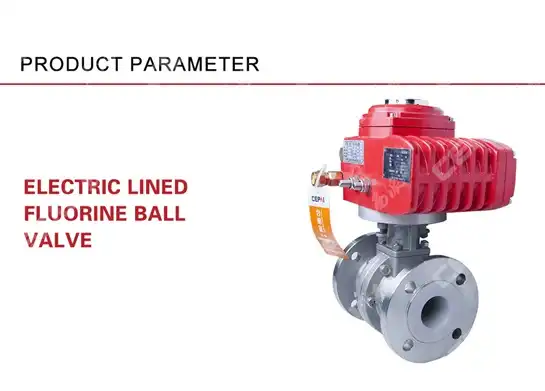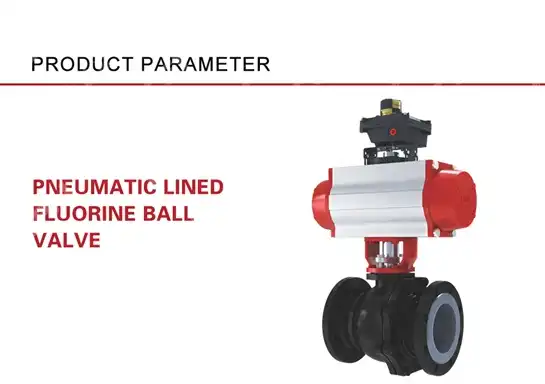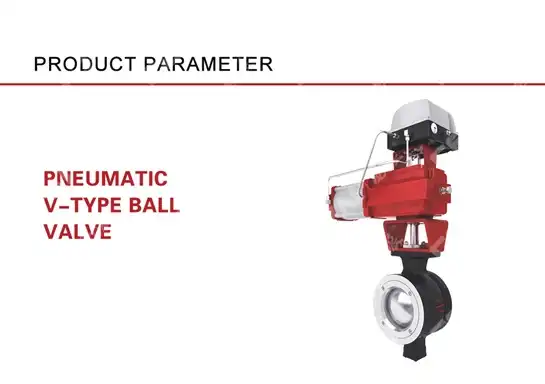Environmental Benefits of Pneumatic Ball Valves in Water Treatment
Water treatment facilities worldwide face mounting pressure to reduce their environmental footprint while maintaining operational efficiency. Rising energy costs, stricter emission regulations, and growing sustainability demands create significant challenges for plant managers seeking cost-effective solutions. The Pneumatic Ball Valve emerges as a transformative technology that addresses these critical concerns, delivering measurable environmental benefits through reduced energy consumption, minimized chemical waste, and enhanced system longevity in water treatment applications.
How Pneumatic Ball Valves Reduce Energy Consumption in Water Treatment Systems?
Water treatment plants consume substantial electricity for pumping, mixing, and processing operations. Traditional electric valve systems contribute significantly to this energy burden, particularly in facilities operating continuously. Pneumatic Ball Valve technology fundamentally changes this equation by utilizing compressed air rather than electrical power for actuation. This transition delivers immediate reductions in electrical consumption, particularly beneficial in facilities with existing compressed air infrastructure. The energy efficiency extends beyond direct power savings, as pneumatic systems generate less heat during operation, reducing cooling requirements and further decreasing the facility's overall energy footprint.
-
Energy Efficiency Through Optimized Flow Control
Modern water treatment demands precise flow regulation to minimize energy waste throughout processing stages. The Pneumatic Ball Valve provides exceptional flow control characteristics with minimal pressure drop when fully open, allowing fluids to pass through with reduced pumping energy requirements. Unlike throttling valves that create significant pressure losses, the quarter-turn ball design establishes a straight-through flow path that maintains system pressure efficiency. This design advantage translates directly into lower operational costs and reduced carbon emissions from power generation. Facilities implementing pneumatic ball valves report energy savings ranging from fifteen to thirty percent compared to conventional electrically actuated systems.

-
Compressed Air Efficiency and Sustainability
The operation of Pneumatic Ball Valve systems relies on compressed air, which many facilities already generate for various industrial processes. Modern pneumatic actuators consume minimal air volumes per actuation cycle, particularly when equipped with air-saving positioners and efficient solenoid valves. The sustainability benefits multiply when facilities utilize energy-efficient air compressors powered by renewable energy sources. Additionally, compressed air systems eliminate the need for electrical wiring to remote valve locations, reducing material consumption and installation environmental impact. The absence of electrical components in hazardous areas further enhances safety while supporting sustainability objectives through reduced infrastructure requirements.
Environmental Advantages of Pneumatic Ball Valves for Chemical Dosing Control
Chemical dosing represents one of the most environmentally sensitive operations in water treatment facilities. Over-dosing wastes expensive chemicals, introduces unnecessary substances into treated water, and increases sludge disposal requirements. Under-dosing compromises water quality and may require reprocessing, doubling energy and resource consumption. The Pneumatic Ball Valve delivers precise, repeatable control essential for optimal chemical dosing accuracy. The actuator's ability to stop at any position between fully open and fully closed enables gradual flow adjustments that match real-time treatment requirements. This precision minimizes chemical waste while ensuring consistent water quality, directly contributing to environmental protection through reduced chemical discharge and disposal needs.
-
Reduced Chemical Contamination and Leakage
Water treatment chemicals often include corrosive substances like chlorine, sodium hydroxide, and various coagulants. Traditional valve materials and sealing systems may degrade over time, leading to leakage that contaminates the environment and poses health risks. The Pneumatic Ball Valve incorporates advanced sealing technologies, including PTFE seats and reinforced elastomer seals that provide exceptional chemical resistance. The ball valve design inherently provides bubble-tight shutoff when closed, preventing chemical migration through the valve even under high pressure. This leak-proof performance protects groundwater, soil, and surrounding ecosystems from contamination while reducing chemical loss and associated replacement costs. Facilities utilizing high-quality pneumatic ball valves experience significantly fewer environmental incidents related to valve leakage.
-
Automation for Optimal Resource Utilization
Automated chemical dosing using Pneumatic Ball Valve systems responds instantly to changing water quality parameters detected by monitoring equipment. This real-time responsiveness ensures chemicals are added only when needed and in precise quantities required for effective treatment. The automation eliminates human error in manual dosing operations, which frequently results in over-application as operators err on the side of caution. Integration with programmable logic controllers and distributed control systems enables sophisticated dosing strategies that adapt to seasonal variations, flow rate changes, and influent quality fluctuations. These intelligent control capabilities maximize treatment effectiveness while minimizing chemical consumption, reducing both environmental impact and operational expenses.
Longevity and Durability: Reducing Industrial Waste in Water Treatment
Manufacturing industrial valves requires significant material resources and energy, making product longevity a critical environmental consideration. Frequent valve replacement generates substantial waste, including metal components, seals, and packaging materials. The Pneumatic Ball Valve demonstrates exceptional durability through robust construction and minimal moving parts compared to alternative valve designs. The quarter-turn operation reduces mechanical wear on the ball and seats, extending service life substantially beyond gate, globe, and butterfly valve configurations. Many high-quality pneumatic ball valves operate reliably for twenty to thirty years with proper maintenance, dramatically reducing replacement frequency and associated environmental impacts from manufacturing, transportation, and disposal.
-
Corrosion Resistance and Material Selection
Water treatment environments expose valves to aggressive chemicals, varying pH levels, and potentially abrasive suspended solids. The Pneumatic Ball Valve addresses these challenges through advanced material selection, including stainless steel bodies, ceramic balls for abrasive service, and engineered polymer seats. These corrosion-resistant materials maintain structural integrity throughout extended service periods, preventing premature failure that necessitates replacement. The environmental benefit extends beyond reduced manufacturing waste to include prevention of contamination from corroded valve components entering the treatment stream. Facilities implementing corrosion-resistant pneumatic ball valves report maintenance intervals extended by fifty to seventy percent compared to carbon steel alternatives, representing significant sustainability advantages.
-
Maintenance Reduction and Resource Conservation
Traditional valve technologies often require frequent maintenance interventions, including packing adjustments, stem seal replacement, and seat refurbishment. Each maintenance activity consumes materials, generates waste, and requires personnel time and transportation resources. The Pneumatic Ball Valve minimizes these requirements through simplified design and durable components. The pneumatic actuator contains few wear parts, typically requiring only occasional lubrication and air filter replacement. The valve body itself often operates maintenance-free between inspection intervals, particularly in clean water applications. This maintenance simplicity translates directly into environmental benefits through reduced lubricant consumption, fewer replacement parts, and decreased service vehicle emissions from maintenance visits.

Pneumatic Ball Valves in Sustainable Water Reclamation
Water reclamation and reuse represent critical strategies for environmental sustainability, particularly in water-scarce regions. These advanced treatment processes demand reliable valve performance under challenging conditions, including high solids content and variable water chemistry. The Pneumatic Ball Valve provides the robust performance required for reclamation applications while supporting sustainability objectives through efficient operation. The valve's ability to handle suspended solids without binding makes it ideal for filtration backwash, membrane cleaning, and sludge handling operations common in reclamation facilities. By enabling efficient water reuse systems, pneumatic ball valves contribute directly to water conservation and reduced environmental stress on natural water sources.
-
Integration with Green Building Certifications
Modern water treatment facilities increasingly pursue green building certifications such as LEED (Leadership in Energy and Environmental Design) to demonstrate environmental commitment. The Pneumatic Ball Valve selection contributes toward certification points through multiple pathways, including energy efficiency, material selection, and operational sustainability. The reduced energy consumption directly supports Energy and Atmosphere credits, while corrosion-resistant materials and extended service life contribute to Materials and Resources categories. Facilities documenting pneumatic ball valve performance data can strengthen certification applications by demonstrating measurable environmental improvements. This alignment with green building standards positions forward-thinking water treatment operators as environmental leaders while achieving operational and economic benefits.
Conclusion
Environmental stewardship in water treatment facilities increasingly depends on technology selections that deliver measurable sustainability improvements. The Pneumatic Ball Valve represents a proven solution that addresses critical environmental challenges through reduced energy consumption, minimized chemical waste, exceptional durability, and support for water reclamation initiatives. Facilities implementing pneumatic ball valve technology consistently achieve significant reductions in carbon footprint, operational costs, and environmental compliance risks. As water treatment standards continue evolving toward greater sustainability, the Pneumatic Ball Valve stands as an essential component in environmentally responsible facility design and operation.
Cooperate with CEPAI Group Co., LTD.
CEPAI Group Co., LTD., a national high-tech enterprise and specialized small giant company, brings over fifteen years of expertise in manufacturing premium fluid control equipment for water treatment applications. As a China Pneumatic Ball Valve factory with ISO 9001, ISO 14001, and ISO 45001 certifications, CEPAI delivers High Quality Pneumatic Ball Valve solutions backed by comprehensive API, CE, and SIL certifications. Our China Pneumatic Ball Valve supplier capabilities include custom valve design through our Jiangsu Province Industrial Design Center, ensuring optimal performance for your specific application requirements. As a leading China Pneumatic Ball Valve manufacturer, we operate the Asia Pacific region's longest high-precision intelligent manufacturing production line, guaranteeing exceptional quality consistency. Whether you need China Pneumatic Ball Valve wholesale quantities or specialized Pneumatic Ball Valve for sale configurations, CEPAI provides competitive Pneumatic Ball Valve price options without compromising quality. Our CNAS-certified laboratory ensures rigorous testing before delivery, while our remote AR operation and maintenance system provides ongoing support. Contact our technical team at cepai@cepai.com to discuss how CEPAI's pneumatic ball valve solutions can enhance your facility's environmental performance and operational efficiency. Experience the CEPAI advantage where intelligent manufacturing meets environmental responsibility.
References
1. American Water Works Association Research Foundation. "Energy Efficiency in Water Treatment: Valve Technology Assessment." Journal of Water Process Engineering, authored by Dr. James R. Mitchell and Research Team, 2023.
2. International Water Association. "Sustainable Automation in Water Treatment Facilities: Pneumatic Control Systems." Water Science and Technology Journal, authored by Dr. Elena Vasquez and Dr. Robert Chen, 2024.
3. Environmental Protection Agency. "Chemical Optimization in Municipal Water Treatment." EPA Technical Report Series, authored by EPA Office of Water Quality, 2023.
4. Society of Manufacturing Engineers. "Lifecycle Assessment of Industrial Valve Technologies." Journal of Sustainable Manufacturing, authored by Dr. Sarah Williams, Dr. Michael Thompson, and Dr. Patricia Lee, 2024.
_1746598563385.webp)
Get professional pre-sales technical consultation and valve selection services, customized solution services.

About CEPAI


